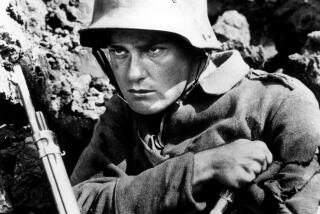Scary stuff, on screen and in real life
- Share via
During the 1920s, silent screen star Lon Chaney was known as “The Man of a Thousand Faces” because of his uncanny ability to transform himself through makeup, appliances and brilliant acting skills into a series of often tortured, grotesque and even demonic characters. Perhaps the best-known was the title role in the 1925 film “The Phantom of the Opera.”
Nearly eight decades after the film’s initial release, Chaney’s performance in the extravagant adaptation of Gaston Leroux’s bestselling twist to the old “Beauty and the Beast” tale still terrifies audiences. One of the most indelible scenes in movie history occurs when he is unmasked and reveals his horrifying skeletal face for the first time.
A new two-disc DVD set of “Phantom” from Milestone Film & Video ($25) reveals the countless problems the film endured during production and even after it was completed.
Chaney’s relationship with director Rupert Julian was strained from the outset and got so bad during production that they would only communicate through an intermediary -- the cinematographer. Even then, Chaney took no heed of Julian’s direction and just did what he felt was best for the scene.
And no fewer than five versions of “Phantom” were released in theaters, including a 1929 partial remake that incorporated dialogue and music.
The DVD set includes the 1925 general-release version and a 1930 international-release version restored in the mid-1990s by film historian Kevin Brownlow’s Photoplay Productions.
The discs also include commentary from Scott MacQueen, who produced the set for Milestone; still galleries of deleted scenes from the original San Francisco and Los Angeles premieres; the trailers from the 1925 and 1929 versions; an audio interview with cinematographer Charles Van Enger; and an interview with Carla Laemmle -- the 93-year-old niece of Universal’s founder, Carl Laemmle -- who plays a ballerina in the film.
MacQueen became intrigued with “Phantom” when he was a kid. “I read the book before I saw the movie,” he recalls. “I saw the film as a teenager and could see how troubled it was. In the late ‘80s, when the Broadway musical opened, I began wondering on my own about the [Chaney] one and began doing a little bit of research and realized there was quite a tale there.”
Universal spared no expense in 1924 to bring Leroux’s tale to the big screen. The studio had enjoyed enormous success the year before with Chaney’s version of Victor Hugo’s “The Hunchback of Notre Dame” and was determined to repeat it.
But its plans to release the film in February 1925 were scrapped after a disastrous January preview in Los Angeles.
MacQueen says the biggest problem was “the ending, which was faithful to the novel, where he [the Phantom] dies of unrequited love because Christine finally shows him pity and kisses him. Audiences didn’t buy it.”
Universal panicked and whipped up a new script that featured a more action-packed ending and a whole new subplot between Christine (Mary Philbin) and several suitors.
This version had an abysmal test engagement in San Francisco. The convoluted subplot with Christine and the men in her life stopped the Phantom’s story cold; those scenes were thrown out.
The DVD features the most complete version of what the general public finally saw in 1925, which is a combination of Julian’s version and the San Francisco edition. Unfortunately, the quality of the print is dismal.
“All that is left of the 1925 version are indifferently made 16mm prints that were made for home movie viewing in the 1930s,” says MacQueen.
With the advent of sound in 1927, Universal wanted to make a sequel to “Phantom.” But Chaney was under contract at MGM, so the studio decided to do a partial remake with dialogue and some new footage involving other characters.
No print of that 1929 version of “Phantom” exists, save for the soundtrack. The restored version on the DVD is from the 1930 international version, which features some new footage, including a scene of an opera singer performing, but no other dialogue. For the DVD, though, some of the 1929 dialogue has been edited in so viewers can get a sense of what the sound version was like. And for those who want to hear all the dialogue from 1929, the flowery prose is on a separate track.
More to Read
Only good movies
Get the Indie Focus newsletter, Mark Olsen's weekly guide to the world of cinema.
You may occasionally receive promotional content from the Los Angeles Times.











